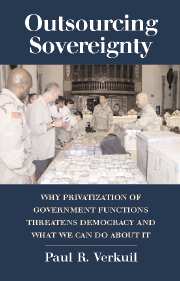 Outsourcing Sovereignty
Outsourcing Sovereignty Book contents
- Frontmatter
- Contents
- Acknowledgments
- Chart
- 1 Introduction and Overview – Why Outsourcing Threatens Democracy
- 2 The Outsourcing of Sovereignty
- 3 Case Study: Public and Private Approaches to Transportation Security
- 4 The Public-Private Distinction
- 5 The Case for Constitutional Governance
- 6 Statutory and Administrative Limitations on Private Delegations
- 7 Outsourcing Government Services: Contract Theory and Practice
- 8 Structural Reforms to Government
- 9 Conclusions (Wherein the Principal Instructs Her Agents)
- Cases
- Bibliography
- Index
2 - The Outsourcing of Sovereignty
Published online by Cambridge University Press: 27 July 2009
- Frontmatter
- Contents
- Acknowledgments
- Chart
- 1 Introduction and Overview – Why Outsourcing Threatens Democracy
- 2 The Outsourcing of Sovereignty
- 3 Case Study: Public and Private Approaches to Transportation Security
- 4 The Public-Private Distinction
- 5 The Case for Constitutional Governance
- 6 Statutory and Administrative Limitations on Private Delegations
- 7 Outsourcing Government Services: Contract Theory and Practice
- 8 Structural Reforms to Government
- 9 Conclusions (Wherein the Principal Instructs Her Agents)
- Cases
- Bibliography
- Index
Summary
The use of private contractors to do the work of government has been going on since the post–World War II period. And concern about the negative consequences of these activities has been expressed for just as long. We need only to remember the prescient words of President Eisenhower in his farewell address: “In the councils of government, we must guard against the acquisition of unwarranted influence … by the military industrial complex.” Spending on federal contracts has now reached over $381 billion annually, which means 40 percent of every discretionary dollar is spent with private companies. Obviously, the military-industrial complex has had a good run.
But in the last decade the transfer of public power to private hands has expanded in new directions. The military-industrial complex President Eisenhower warned us against has entered new territory. No longer limited to the production of military equipment, it now seeks to provide personnel for military-style incursions in a variety of foreign settings and it proposes to secure our borders.
This chapter will describe situations in which the transfer of government power to private contractors is most pronounced. Some situations are cutting-edge, some traditional and relatively well accepted, and some are hardly even recognized as sovereignty transfer situations. But each stems from the same basic problem – an emptiness at the center. Private contractors are necessary because government is often inadequately staffed to do its job directly.
- Type
- Chapter
- Information
- Outsourcing SovereigntyWhy Privatization of Government Functions Threatens Democracy and What We Can Do about It, pp. 23 - 56Publisher: Cambridge University PressPrint publication year: 2007
- 1
- Cited by


